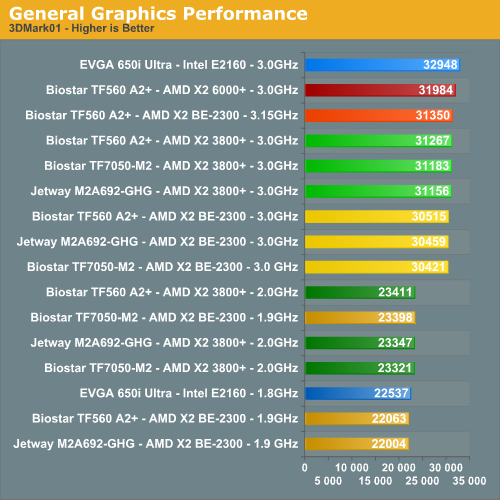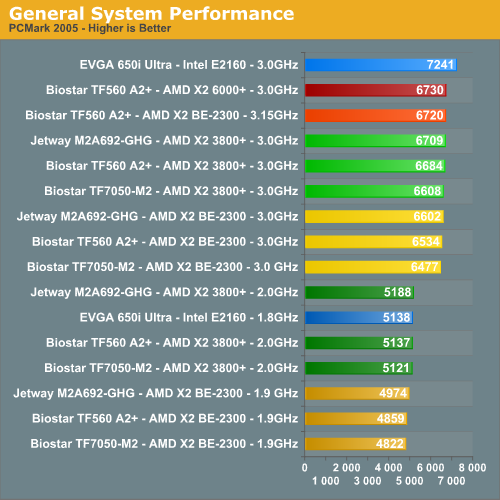Biostar TF560 A2+: Overclocking NVIDIA's new nForce 560
by Gary Key on August 2, 2007 12:15 AM EST- Posted in
- Motherboards
Synthetic Graphics Performance
The 3DMark series of benchmarks developed and provided by Futuremark are among the most widely used tools for benchmark reporting and comparisons. Although the benchmarks are very useful for providing apples-to-apples comparisons across a broad array of GPU and CPU configurations they are not a substitute for actual application and gaming benchmarks. In this sense we consider the 3DMark benchmarks to be purely synthetic in nature but still very valuable for providing consistent measurements of performance.


In our 3DMark06 test, our budget level processors are bunched together with a 6.5% spread between the three at stock settings. As expected the X2 3800+ edges out the E2160 and BE-2300 at stock settings in this CPU intensive benchmark but the Intel Core architecture comes alive in our first overclocking result. The spread is only 4.3% at the top with our latency deprived BE-2300 needing an additional overclock to 3.15GHz to overtake our X2 6000+ reference CPU. The BE-2300 has a performance increase of 38% when overclocked while the X2 3800+ improves by 33%. That's not bad for either CPU, considering that when combined with the Biostar TF560 A2+ board they still cost less than the X2 6000+ CPU.
In the more memory/CPU throughput sensitive 3DMark01 benchmark we see the same pattern at stock settings. The spread from top to bottom is 6.4% at stock but increases to 8.3% during overclocking. However, the differences in performance are not really noticeable in either 3DMark application unless you are looking for higher benchmark scores. The BE-2300 has an overclocking performance increase of 40% while the X2 3800+ only improves by 33%, mainly due to its lower HTT setting.
Looking at the three AM2 motherboards/chipsets, all of the CPU results tend to be clustered closely together with one exception. The BE-2300 in the nF7050 board outperforms the other two chipsets by 6% in 3DMark01. It appears that the BIOS on that board may be somewhat better tuned for the Brisbane core, though when we asked for more details we couldn't get a straight answer from any of the involved parties.
General System Performance
The PCMark05 benchmark developed and provided by Futuremark was designed for determining overall system performance for the typical home computing user. This tool provides both system and component level benchmarking results utilizing subsets of real world applications or programs. This benchmark is useful for providing comparative results across a broad array of Graphics, CPU, Hard Disk, and Memory configurations along with multithreading results. In this sense we consider the PCMark benchmark to be both synthetic and real world in nature, and it again provides for consistency in our benchmark results.

The performance spread in the stock score is 7.6% and 11.8% when overclocked, although in individual areas the differences between the CPUs may be more or less pronounced. In fact, it was in the first and third multitasking tests where our BE-2300 trailed our other solutions in both stock and overclocked settings. This is due in part to increased latencies in the L2 cache and the reduction in memory speed when compared to our other two budget CPUs. The BE-2300 has a performance increase of 34% while the X2 3800+ improves by 30% when overclocked; meanwhile, the E2160 improves by 41% with overclocking.
All three AM2 boards are clustered within about 1.5% of each other (about the margin of error in PCMark05), although the spread is slightly higher at 3% with the stock Brisbane core. This time, the 690G Jetway board ends up being the fastest of the three AM2 options, while the nF7050 finishes in third place - not that anyone would really notice a 1% difference in practice outside of running benchmarks.
The 3DMark series of benchmarks developed and provided by Futuremark are among the most widely used tools for benchmark reporting and comparisons. Although the benchmarks are very useful for providing apples-to-apples comparisons across a broad array of GPU and CPU configurations they are not a substitute for actual application and gaming benchmarks. In this sense we consider the 3DMark benchmarks to be purely synthetic in nature but still very valuable for providing consistent measurements of performance.


In our 3DMark06 test, our budget level processors are bunched together with a 6.5% spread between the three at stock settings. As expected the X2 3800+ edges out the E2160 and BE-2300 at stock settings in this CPU intensive benchmark but the Intel Core architecture comes alive in our first overclocking result. The spread is only 4.3% at the top with our latency deprived BE-2300 needing an additional overclock to 3.15GHz to overtake our X2 6000+ reference CPU. The BE-2300 has a performance increase of 38% when overclocked while the X2 3800+ improves by 33%. That's not bad for either CPU, considering that when combined with the Biostar TF560 A2+ board they still cost less than the X2 6000+ CPU.
In the more memory/CPU throughput sensitive 3DMark01 benchmark we see the same pattern at stock settings. The spread from top to bottom is 6.4% at stock but increases to 8.3% during overclocking. However, the differences in performance are not really noticeable in either 3DMark application unless you are looking for higher benchmark scores. The BE-2300 has an overclocking performance increase of 40% while the X2 3800+ only improves by 33%, mainly due to its lower HTT setting.
Looking at the three AM2 motherboards/chipsets, all of the CPU results tend to be clustered closely together with one exception. The BE-2300 in the nF7050 board outperforms the other two chipsets by 6% in 3DMark01. It appears that the BIOS on that board may be somewhat better tuned for the Brisbane core, though when we asked for more details we couldn't get a straight answer from any of the involved parties.
General System Performance
The PCMark05 benchmark developed and provided by Futuremark was designed for determining overall system performance for the typical home computing user. This tool provides both system and component level benchmarking results utilizing subsets of real world applications or programs. This benchmark is useful for providing comparative results across a broad array of Graphics, CPU, Hard Disk, and Memory configurations along with multithreading results. In this sense we consider the PCMark benchmark to be both synthetic and real world in nature, and it again provides for consistency in our benchmark results.

The performance spread in the stock score is 7.6% and 11.8% when overclocked, although in individual areas the differences between the CPUs may be more or less pronounced. In fact, it was in the first and third multitasking tests where our BE-2300 trailed our other solutions in both stock and overclocked settings. This is due in part to increased latencies in the L2 cache and the reduction in memory speed when compared to our other two budget CPUs. The BE-2300 has a performance increase of 34% while the X2 3800+ improves by 30% when overclocked; meanwhile, the E2160 improves by 41% with overclocking.
All three AM2 boards are clustered within about 1.5% of each other (about the margin of error in PCMark05), although the spread is slightly higher at 3% with the stock Brisbane core. This time, the 690G Jetway board ends up being the fastest of the three AM2 options, while the nF7050 finishes in third place - not that anyone would really notice a 1% difference in practice outside of running benchmarks.










21 Comments
View All Comments
chesterman86 - Sunday, August 5, 2007 - link
any one knows which boards will work with am2+ processorsi've a evga 590sli, with a x2 4200. it will be great if i could upgrade to a phenom =D
anyway, even if i do the bios update, i'll not have ht3 right?
lopri - Saturday, August 4, 2007 - link
Thanks for the great review. The board reviewed looks solid and the coverage is, as usual, complete and clear. I always liked BioStar's boards and felt their products are not getting much spotlight among enthusiasts. The board and NV's new chipset looks solid and it's really amazing that how much computing power we get for the dollars these days.Said that, I'd like to know if Gary thinks the review samples are representative enough for retail products that one can buy, when it comes to overclocking? I haven't kept up with AMD's latest steppings and the overclocking performance of the reviewed CPUs is simply amazing. I remember the time when a 3.0GHz A64 was considered a golden.
lopri - Saturday, August 4, 2007 - link
Forgot to ask: What is the thing that going for NF560? There was a brief mention regarding GPU optimazation and PCI-E lane configuration, but overall it looks almost identical to NF550. If one were to buy a either similarly priced NF550 board or NF560 board, what would differentiate 560 from 550?CrystalBay - Thursday, August 2, 2007 - link
That is some incredible value right there .Thanks for the article G.K.!!!
Powered by AMD - Thursday, August 2, 2007 - link
Why do you use a U$S 100 Motherboard with the Intel setup and a U$S 80 one for the AMD?If we are in the cheap setup, i would like to make a comparision apples to apples.
I think if you use the U$S 85 JetWay J966GDAG-PB, the tables should be much different.
yyrkoon - Friday, August 3, 2007 - link
You try finding a decent enough Intel motherboard for under $100. Most people I know wouldnt even settle for less than a $150 + board concerning an Intel system. In-expencive/good AMD motherboards with a decent feature list have been around for a while, open your eyes, and do a product search of your own . . .crimson117 - Thursday, August 2, 2007 - link
Good point!
Also, the processors costs are not equal... (newegg prices)
Athlon 64 X2 3800+ costs $65
AMD X2 BE-2300 costs $90
Intel E2160 costs $95
AMD Athlon 64 X2 6000+ costs $170
So the AMD setup would be $50 cheaper for about equal performance.
DeepThought86 - Thursday, August 2, 2007 - link
2 PATA ports supproted but only one implemented on this board. Boo, hiss. So Biostar saves $0.50 and we're out $100 buying a new driveelpresidente2075 - Thursday, August 2, 2007 - link
All I have to say is: You've gotta move forward sometime. PATA is OK if you like slow, bulky, and outdated interfaces, but if you're into the whole "having a decent computer" thing, you're gonna have to spend the money anyway.And if you mean that you've just purchased a large PATA drive and don't want to purchase a new SATA one, I pity you and your short-sightedness. PATA is going the way of the Dodo, and SATA is the future for now.
Good luck with the new drive!
LoneWolf15 - Saturday, August 4, 2007 - link
This one made me laugh.
Not because PATA isn't an old interface. But, compare the speeds of a modern PATA drive to an SATA drive, and you'll find almost no difference. The interface isn't the bottleneck; the drive mechanics are. For that reason, an UltraATA Seagate 7200.10 and a SATA Seagate 7200.10 are within a hairsbreadth in performance.
SATA certainly cables nicer than PATA, and getting rid of the whole master/slave configuration is a great thing too. But you're buying into the hype a little too heavily. Until we can improve drive mechanics to both increase data throughput and decrease latency in more than tiny incremental steps, the interface won't matter all that much.